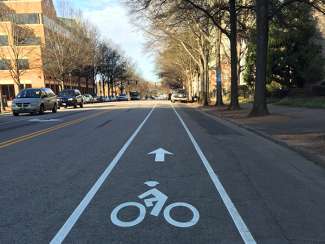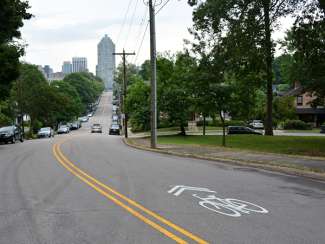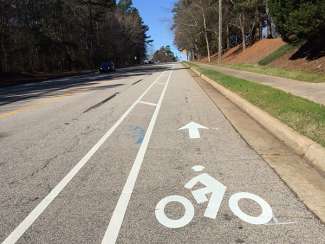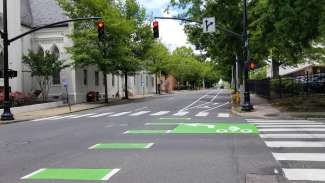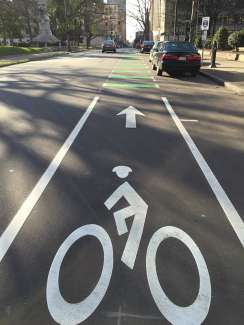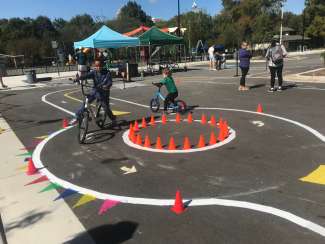Jump To:
Conventional Bike Lanes
Conventional bike lanes dedicate exclusive space in the street for bicyclists. They include a solid white stripe between the general travel lane and the bike lane and are marked by a bicyclist symbol and arrow indicating the direction of travel. Conventional bike lanes are typically dashed near intersections to help bicyclists avoid collisions with right-turning motor vehicles. Drivers should look for bicyclists, especially at intersections and driveways, and then merge into the bike lane to turn right.
Sharrows
Shared lane markings, also known as sharrows, are markings in the street that look like a bicycle and two chevrons. Sharrows help bicyclists position themselves to be visible and to avoid parked cars while riding in the street. Sharrows also help to remind motorists to look for bicyclists. Even when sharrows aren’t present, bicyclists are legally allowed to ride in the travel lane.
Buffered Bike Lanes
Buffered bike lanes are bike lanes that have a painted buffer between the bike lane and the general travel lane. In some cases, the painted buffer might appear between the bike lane and on-street parking to help bicyclists avoid opening car doors. Drivers should always look for bicyclists before opening car doors.
Two-Stage Turn Boxes
Two-stage turn boxes provide space for bicyclists to make left turns at intersections.
To use a two-stage turn box, move into the bike box and face your new direction of travel, then proceed across the intersection when the light turns green.
Green Bike Lanes
Green bike lanes function in the same way as conventional bike lanes. The green paint is intended to increase motorist awareness of bike lanes and bicyclists riding in them. Dashed green bike lanes indicate potential conflict zones between motor vehicle and bicycle traffic, and both motorists and bicyclists should approach these locations with caution. Where green bike lanes are dashed at intersections, drivers should merge into the bike lane to turn right after making sure the bike lane is clear.
More info on Green Bike Lanes and Bike Boxes
Traffic Garden
A Traffic Garden is a play-based learning environment with small-scale streets for educational programs, bike-skill development, and active play for all ages and abilities. Traffic Gardens provide a safe place away from moving vehicles to learn traffic rules and develop navigational skills.
The City of Raleigh provides temporary Traffic Gardens at kid-friendly events throughout the city. Read detailed plans for expanding Traffic Garden programming or contact Bee Persson to learn how you can host a Traffic Garden at your next event.
